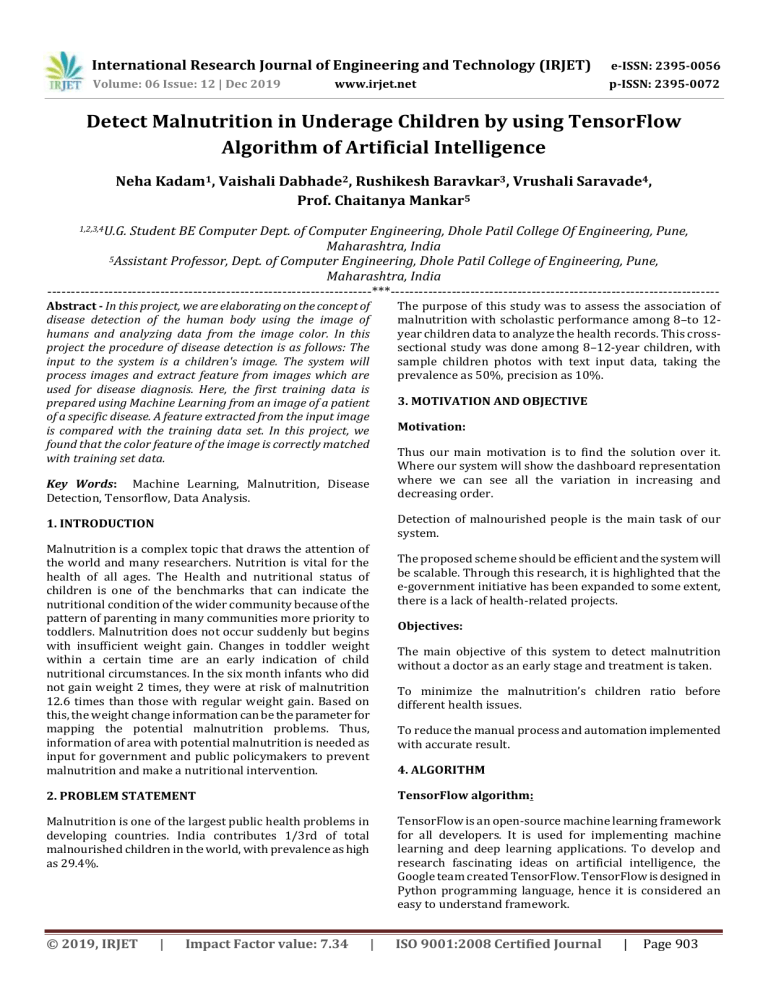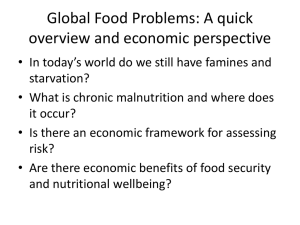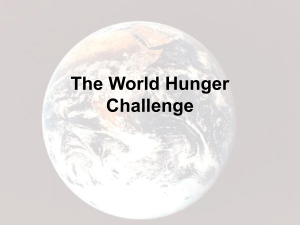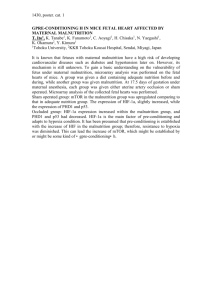IRJET- Detect Malnutrition in Underage Children by using Tensorflow Algorithm of Artificial Intelligence
advertisement

International Research Journal of Engineering and Technology (IRJET)
e-ISSN: 2395-0056
Volume: 06 Issue: 12 | Dec 2019
p-ISSN: 2395-0072
www.irjet.net
Detect Malnutrition in Underage Children by using TensorFlow
Algorithm of Artificial Intelligence
Neha Kadam1, Vaishali Dabhade2, Rushikesh Baravkar3, Vrushali Saravade4,
Prof. Chaitanya Mankar5
1,2,3,4U.G.
Student BE Computer Dept. of Computer Engineering, Dhole Patil College Of Engineering, Pune,
Maharashtra, India
5Assistant Professor, Dept. of Computer Engineering, Dhole Patil College of Engineering, Pune,
Maharashtra, India
---------------------------------------------------------------------***----------------------------------------------------------------------
Abstract - In this project, we are elaborating on the concept of
disease detection of the human body using the image of
humans and analyzing data from the image color. In this
project the procedure of disease detection is as follows: The
input to the system is a children's image. The system will
process images and extract feature from images which are
used for disease diagnosis. Here, the first training data is
prepared using Machine Learning from an image of a patient
of a specific disease. A feature extracted from the input image
is compared with the training data set. In this project, we
found that the color feature of the image is correctly matched
with training set data.
Key Words: Machine Learning, Malnutrition, Disease
Detection, Tensorflow, Data Analysis.
The purpose of this study was to assess the association of
malnutrition with scholastic performance among 8–to 12year children data to analyze the health records. This crosssectional study was done among 8–12-year children, with
sample children photos with text input data, taking the
prevalence as 50%, precision as 10%.
3. MOTIVATION AND OBJECTIVE
Motivation:
Thus our main motivation is to find the solution over it.
Where our system will show the dashboard representation
where we can see all the variation in increasing and
decreasing order.
Detection of malnourished people is the main task of our
system.
1. INTRODUCTION
Malnutrition is a complex topic that draws the attention of
the world and many researchers. Nutrition is vital for the
health of all ages. The Health and nutritional status of
children is one of the benchmarks that can indicate the
nutritional condition of the wider community because of the
pattern of parenting in many communities more priority to
toddlers. Malnutrition does not occur suddenly but begins
with insufficient weight gain. Changes in toddler weight
within a certain time are an early indication of child
nutritional circumstances. In the six month infants who did
not gain weight 2 times, they were at risk of malnutrition
12.6 times than those with regular weight gain. Based on
this, the weight change information can be the parameter for
mapping the potential malnutrition problems. Thus,
information of area with potential malnutrition is needed as
input for government and public policymakers to prevent
malnutrition and make a nutritional intervention.
The proposed scheme should be efficient and the system will
be scalable. Through this research, it is highlighted that the
e-government initiative has been expanded to some extent,
there is a lack of health-related projects.
Objectives:
The main objective of this system to detect malnutrition
without a doctor as an early stage and treatment is taken.
To minimize the malnutrition’s children ratio before
different health issues.
To reduce the manual process and automation implemented
with accurate result.
4. ALGORITHM
2. PROBLEM STATEMENT
TensorFlow algorithm:
Malnutrition is one of the largest public health problems in
developing countries. India contributes 1/3rd of total
malnourished children in the world, with prevalence as high
as 29.4%.
TensorFlow is an open-source machine learning framework
for all developers. It is used for implementing machine
learning and deep learning applications. To develop and
research fascinating ideas on artificial intelligence, the
Google team created TensorFlow. TensorFlow is designed in
Python programming language, hence it is considered an
easy to understand framework.
© 2019, IRJET
|
Impact Factor value: 7.34
|
ISO 9001:2008 Certified Journal
|
Page 903
International Research Journal of Engineering and Technology (IRJET)
e-ISSN: 2395-0056
Volume: 06 Issue: 12 | Dec 2019
p-ISSN: 2395-0072
www.irjet.net
It includes a feature that defines, optimizes and calculates
mathematical expressions easily with the help of multidimensional arrays called tensors. Also, it has programming
support for deep neural networks and machine learning
techniques, also a high scalable feature of computation with
various data sets.
5. PROPOSED SYSTEM
Processing module:
Once you get the image from the patient then the proposed
algorithm applies the detection process on that image to find
out the malnutrition patient or not.
Mathematical Model:
Input Set:
We are making a system to detect malnutrition in underage
children using image processing and data analysis. So this
system eliminates the need of a doctor every time to
determine the malnutrition in the subject. In many parts of
the world, due to poverty, many people cannot afford every
time to go to the doctor and therefore, in this case, the
system that we are designing will be very much helpful for
such people. The user is the parents of small children.
The malnutrition child images and text input. Text input is
also through the user. So the set of inputs will be, I1 =
{predefined command, fixed pattern sentential command,
random sentences as command}
I2 = {text, image, remote text} Thus, I=I1UI2
In this system malnutrition, the dataset takes the input from
the user module and stores the data into the database. This
data is very important for the decision making of whether
the subject is affecting from malnutrition or not. It also
consists of the training dataset which is then given to the
data preprocessing modules.
The input I = {all sentences in English via text, all photos in
image format, remote text input}
Output Set:
The output for the specified inputs above will be response
determined by the system according to the input given and
the database containing all the necessary inputs and their
respective outputs.
O1 = {malnutrition accuracy, display, text}
O2 = {GUI, application response} Thus, O = O1 U O2
Output O = {Response for corresponding text input and
image input, Response for corresponding input via GUI,
application response}
6. CONCLUSION
In the presented system, the system analyzes the human
parts and gives probable disease for a person including a
healthy case. Here, for disease prediction image color
(average RGB) value used as an image features. This model
gives more accurate results than the human eye like
subjectivity and resolution power. This may give a more
accurate result for identifying human health conditions using
the machine learning algorithm.
Fig -1: Block Diagram
The main application of this system is to the government to
minimize malnutrition percentage.
User module:
ACKNOWLEDGEMENT
Upload the malnutrition image in this module by a patient to
check the diseases. Here the patient will get the Patient's
health is critical or not caution disease without any doctor
suggestion.
Admin module:
Here admin trains the image dataset based on the medicalrelated backend for analysis and comparison of upcoming
patient images.
© 2019, IRJET
|
Impact Factor value: 7.34
|
I wish to express my profound thanks to all who helped us
directly or indirectly in making this paper. Finally, I wish to
thank all our friends and well-wishers who supported us in
completing this paper successfully I am especially grateful to
our guide Prof. Chaitanya Mankar for him time to time,
very much needed, valuable guidance. Without the full
support and cheerful encouragement of my guide, the paper
would not have been completed on time.
ISO 9001:2008 Certified Journal
|
Page 904
International Research Journal of Engineering and Technology (IRJET)
e-ISSN: 2395-0056
Volume: 06 Issue: 12 | Dec 2019
p-ISSN: 2395-0072
www.irjet.net
Prof. Chaitanya Mankar,
BE Computer,
Dhole Patil College of Engineering,
Wagholi, Pune-412207
REFERENCES
[1]
Cynthia Hayat, Barens Abian, “The Modeling of Artificial
Neural Network of Early Diagnosis for
Malnutrition
with Backpropagation Method”, 2018.
[2]
Bambang Laredo, Liliana Swastina, Husnul Maad unaidi,
“IT Application to Mapping the Potential
of
Malnutrition Problems, 2018.
[3]
Anutosh Maitra, Rambhau Eknath Rote, Nataraj
Kuntagod, “Managing Child Malnutrition via Digital
Enablement: Insights from a Field Trial”, 2017.
[4]
Sri Winiarti, Sri Kusumadewi, Izzati Muhimmah, Herman
Yuliansyah, “Determining The Nutrition of Patient
Based on Food Packaging Product Using Fuzzy C
Means Algorithm”, 2017.
[5]
Rehyan Gupta, Abhishek Singhal,A Sai Sabitha,
“Comparative study of Clustering algorithm conducting
a district-level analysis of malnutrition.”, 2018.
[6]
Liping Yuan, Zhiyin Qu, "A Convolutional Neural Network
based on TensorFlow for Face Recognition”, 2017.
[7]
Xin Jia, “Image Recognition method based on deep
learning”, 2017.
[8]
Sujay Kumar, Varun Saboo, “Dermatological disease
detection using image processing and machine
learning”, 2016.
BIOGRAPHIES
Neha Kadam,
BE Computer,
Dhole Patil College of Engineering,
Wagholi, Pune-412207
Vaishali Dabhade,
BE Computer,
Dhole Patil College of Engineering,
Wagholi, Pune-412207
Rushikesh Baravkar,
BE Computer,
Dhole Patil College of Engineering,
Wagholi, Pune-412207
Vrushali Saravade,
BE Computer,
Dhole Patil College of Engineering,
Wagholi, Pune-412207
© 2019, IRJET
|
Impact Factor value: 7.34
|
ISO 9001:2008 Certified Journal
|
Page 905


